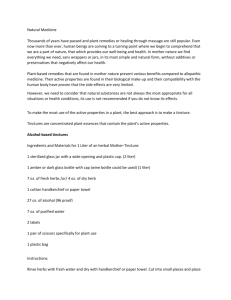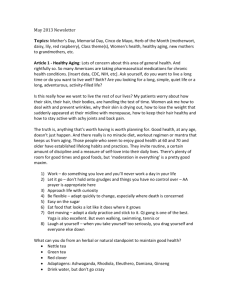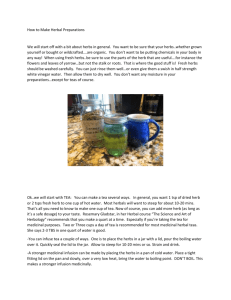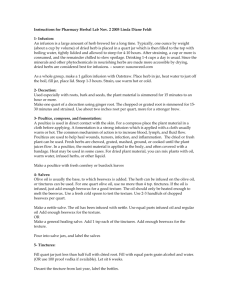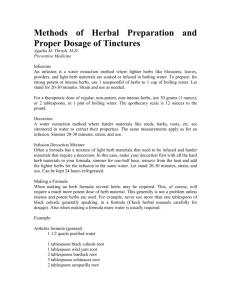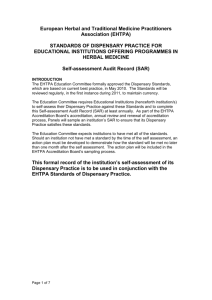tinctures-Elise-Krohn-
advertisement
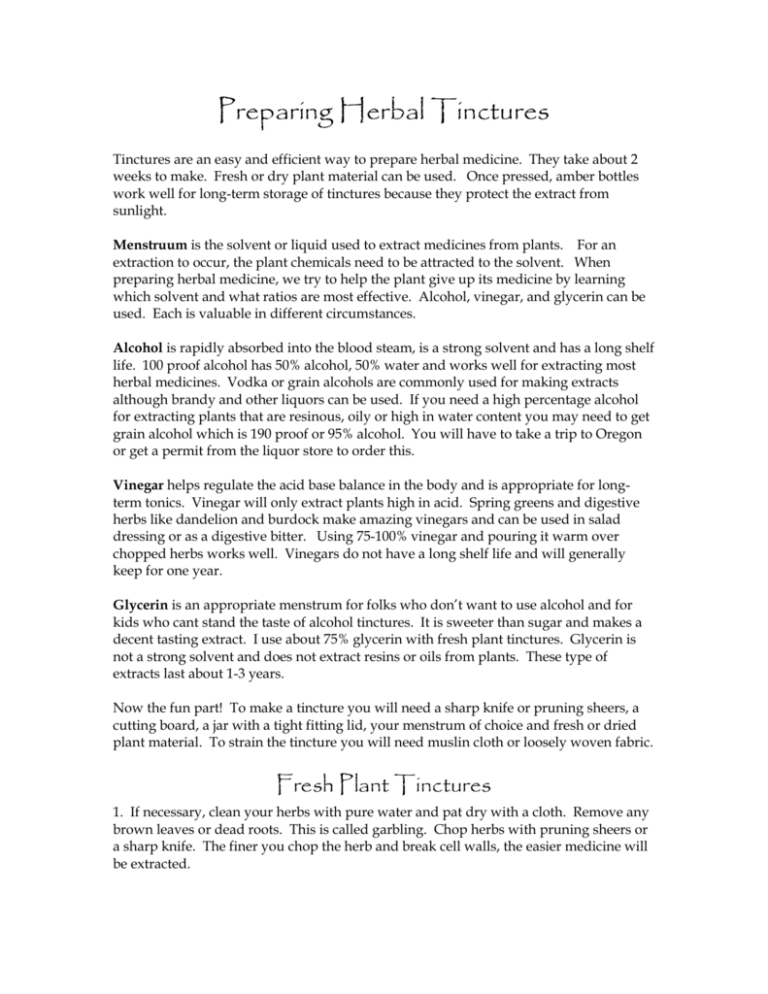
Preparing Herbal Tinctures Tinctures are an easy and efficient way to prepare herbal medicine. They take about 2 weeks to make. Fresh or dry plant material can be used. Once pressed, amber bottles work well for long-term storage of tinctures because they protect the extract from sunlight. Menstruum is the solvent or liquid used to extract medicines from plants. For an extraction to occur, the plant chemicals need to be attracted to the solvent. When preparing herbal medicine, we try to help the plant give up its medicine by learning which solvent and what ratios are most effective. Alcohol, vinegar, and glycerin can be used. Each is valuable in different circumstances. Alcohol is rapidly absorbed into the blood steam, is a strong solvent and has a long shelf life. 100 proof alcohol has 50% alcohol, 50% water and works well for extracting most herbal medicines. Vodka or grain alcohols are commonly used for making extracts although brandy and other liquors can be used. If you need a high percentage alcohol for extracting plants that are resinous, oily or high in water content you may need to get grain alcohol which is 190 proof or 95% alcohol. You will have to take a trip to Oregon or get a permit from the liquor store to order this. Vinegar helps regulate the acid base balance in the body and is appropriate for longterm tonics. Vinegar will only extract plants high in acid. Spring greens and digestive herbs like dandelion and burdock make amazing vinegars and can be used in salad dressing or as a digestive bitter. Using 75-100% vinegar and pouring it warm over chopped herbs works well. Vinegars do not have a long shelf life and will generally keep for one year. Glycerin is an appropriate menstrum for folks who don’t want to use alcohol and for kids who cant stand the taste of alcohol tinctures. It is sweeter than sugar and makes a decent tasting extract. I use about 75% glycerin with fresh plant tinctures. Glycerin is not a strong solvent and does not extract resins or oils from plants. These type of extracts last about 1-3 years. Now the fun part! To make a tincture you will need a sharp knife or pruning sheers, a cutting board, a jar with a tight fitting lid, your menstrum of choice and fresh or dried plant material. To strain the tincture you will need muslin cloth or loosely woven fabric. Fresh Plant Tinctures 1. If necessary, clean your herbs with pure water and pat dry with a cloth. Remove any brown leaves or dead roots. This is called garbling. Chop herbs with pruning sheers or a sharp knife. The finer you chop the herb and break cell walls, the easier medicine will be extracted. 2. Place the herb in a jar and cover with menstruum so there is ¼ to ½ inch of liquid covering the herb. This prevents molding. 3. Cover jar tightly and place in a warm dark area that is easily accessible. Shake the tincture daily, and if you fancy, pray over it or honor the herb however calls you. 4. After at least two weeks, filter the menstruum from the herb with muslin or coarse cloth. Make sure to squeeze out every possible remaining drop to get all of the medicine. 5. Pour the extract into a clean jar and let the sediment fall to the bottom. This takes anywhere from a few hours to over night. You should be left with a beautiful clear liquid. 6. Pour off the liquid without the sediment, then place it in a glass jar. Amber bottles work well for long-term storage because they protect the tincture from sunlight. Label and store in a cool dark place. The Scientific Method I use the more scientific approach for strong herbs with small dosages and for dry tinctures. The only modification to the above instruction is that you weigh you cut herb with a postal or food scale and measure the appropriate number of ounces of menstruum with a measuring cup. The basic proportion for a fresh plant tincture is 1 part herb by weight to 2 parts menstrum by volume. Example: We weigh 4 oz of fresh dandelion root on a scale 4 * 2 = 8 oz of menstrum we will measure in a measuring cup. The procedure after this is the same. Pour the menstrum over the herbs and shake daily for several weeks then strain. Maceration with Dry Plant Material Dry plant tinctures are a little trickier because the herb needs to absorb water and come back to life before the medicine can be extracted. The proportion for dry plant tinctures is 1 part herb by weight to 5 parts menstrum by volume. This amount of menstrum allows the herb to swell up and still be covered with fluid. Example: We have 2 oz of dried dandelion root 2 * 5 = 10 oz of menstrum we will measure and place over the herb. The rest of the process is the same. It is particularly important to shake dry plant tinctures. If you do not have a scale, a more simple approach can be taken by placing the dry herb in a jar and covering it with menstrum so several inches of liquid are over the top of the herbs. As the herb swells keep adding menstrum to cover the herb. Elise Krohn, 2003
